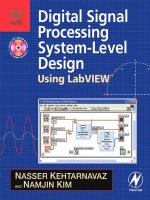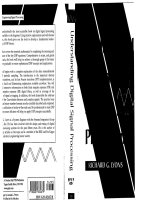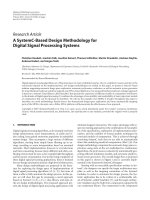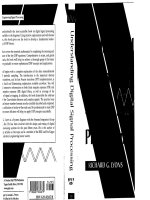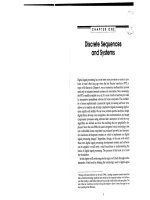Mathematical Summary for Digital Signal Processing Applications with Matlab pdf
Bạn đang xem bản rút gọn của tài liệu. Xem và tải ngay bản đầy đủ của tài liệu tại đây (10.03 MB, 229 trang )
Mathematical Summary for Digital Signal
Processing Applications with Matlab
E.S. Gopi
Mathematical Summary
for Digital Signal Processing
Applications with Matlab
123
E.S. Gopi
National Institute of Technology, Trichy
Dept. Electronics & Communication Engineering
67 Tanjore Main Road
Tiruchirappalli-620015
National Highway
India
ISBN 978-90-481-3746-6 e-ISBN 978-90-481-3747-3
DOI 10.1007/978-90-481-3747-3
Springer Dordrecht Heidelberg London New York
Library of Congress Control Number: 2009944069
c
Springer Science+Business Media B.V. 2010
No part of this work may be reproduced, stored in a retrieval system, or transmitted in any form or by
any means, electronic, mechanical, photocopying, microfilming, recording or otherwise, without written
permission from the Publisher, with the exception of any material supplied specifically for the purpose
of being entered and executed on a computer system, for exclusive use by the purchaser of the work.
Cover design: eStudio Calamar S.L.
Printed on acid-free paper
Springer is part of Springer Science+Business Media (www.springer.com)
Dedicated to my son G.V. Vasig and my wife
G. Viji
Preface
The book titled “Mathematical summary for Digital Signal Processing Applications
with Matlab” consists of Mathematics which is not usually dealt in the DSP core
subject, but used in the DSP applications. Matlab Illustrations for the selective topics
such as generation of Multivariate Gaussian distributed sample outcomes, Optimiza-
tion using Bacterial Foraging etc. are given exclusively as the separate chapter for
better understanding. The book is written in such a way that it is suitable for Non-
mathematical readers and is very much suitable for the beginners who are doing
research in Digital Signal Processing.
E.S. Gopi
vii
Acknowledgements
I am extremely happy to express my thanks to Prof. K.M.M. Prabhu, Indian
Institute of Technology Madras for his constant encouragement. I also thank the
Director Prof. M. Chidambaram, Prof. B. Venkataramani and Prof. S. Raghavan
National Institute of Technology Trichy for their support. I thank those who di-
rectly or indirectly involved in bringing up this Book. Special thanks to my parents
Mr. E. Sankarasubbu and Mrs. E.S. Meena.
ix
Contents
1 Matrices 1
1.1 Properties of Vectors 2
1.2 Properties of Matrices 3
1.3 LDU Decomposition of the Matrix 7
1.4 PLDU Decomposition of an Arbitrary Matrix 10
1.5 Vector Space and Its Properties 12
1.6 Linear Independence, Span, Basis and the Dimension
oftheVectorSpace 12
1.6.1 Linear Independence 12
1.6.2 Span 13
1.6.3 Basis 13
1.6.4 Dimension 13
1.7 Four Fundamental Vector Spaces of the Matrix 13
1.7.1 Column Space 14
1.7.2 Null Space 14
1.7.3 Row Space 14
1.7.4 Left Null Space 14
1.8 Basis of the Four Fundamental Vector Spaces of the Matrix 14
1.8.1 Column Space 15
1.9 Observations on Results of the Example 1.12 20
1.9.1 Column Space 21
1.9.2 Null Space 21
1.9.3 Left Column Space (Row Space) 21
1.9.4 Left Null Space 21
1.9.5 Observation 22
1.10 Vector Representation with Different Basis 22
1.11 Linear Transformation of the Vector 24
1.11.1 Trick to Compute the Transformation Matrix 25
1.12 Transformation Matrix with Different Basis 25
1.13 Orthogonality 26
1.13.1 Basic Definitions and Results 26
1.13.2 Orthogonal Complement 27
1.14 System of Linear Equation 27
xi
xii Contents
1.15 Solutions for the System of Linear Equation [A] x D b 28
1.15.1 Trick to Obtain the Solution 29
1.16 Gram Schmidt Orthonormalization Procedure
for Obtaining Orthonormal Basis 36
1.17 QR Factorization 40
1.18 Eigen Values and Eigen Vectors 42
1.19 Geometric Multiplicity (Versus) Algebraic Multiplicity 44
1.20 Diagonalization of the Matrix 47
1.21 Schur’s Lemma 49
1.22 Hermitian Matrices and Skew Hermitian Matrices 50
1.23 Unitary Matrices 52
1.24 Normal Matrices 56
1.25 Applications of Diagonalization of the Non-deficient Matrix 58
1.26 Singular Value Decomposition 60
1.27 Applications of Singular Value Decomposition 62
2 Probability 67
2.1 Introduction 67
2.2 Axioms of Probability 68
2.3 Class of Events or Field (F) 68
2.4 Probability Space (S, F, P) 68
2.5 Probability Measure 68
2.6 Conditional Probability 69
2.7 Total Probability Theorem 70
2.8 Bayes Theorem 70
2.9 Independence 70
2.10 Multiple Experiments (Combined Experiments) 71
2.11 Random Variable 74
2.12 Cumulative Distribution Function (cdf) of the Random
Variable‘x’ 75
2.13 Continuous Random Variable 76
2.14 Discrete Random Variable 76
2.15 Probability Mass Function 76
2.16 Probability Density Function 76
2.17 Two Random Variables 77
2.18 Conditional Distributions and Densities 79
2.19 Independent Random Variables 79
2.20 Some Important Results on Conditional Density Function .
80
2.21 Transformation of Random Variables of the Type Y D g.X/ 84
2.22 Transformation of Random Variables of the Type
Y1 D g1.X1; X2/; Y2 D g2.X1; X2) 85
2.23 Expectations 99
2.24 Indicator 99
2.25 Moment Generating Function 101
2.26 Characteristic Function 102
Contents xiii
2.27 Multiple Random Variable (Random Vectors) 102
2.28 Gaussian Random Vector with Mean Vector
X
and Covariance Matrix C
X
107
2.29 Complex Random Variables 118
2.30 Sequence of the Number and Its Convergence 119
2.31 Sequence of Functions and Its Convergence 120
2.32 Sequence of Random Variable 120
2.33 Example for the Sequence of Random Variable 122
2.34 Central Limit Theorem 122
3 Random Process 123
3.1 Introduction 123
3.2 Random Variable X
t1
124
3.3 Strictly Stationary Random Process with Order 1 124
3.4 Strictly Stationary Random Process with Order 2 124
3.5 Wide Sense Stationary Random Process 125
3.6 Complex Random Process 127
3.7 Properties of Real and Complex Random Process 127
3.8 Joint Strictly Stationary of Two Random Process 127
3.9 Jointly Wide Sense Stationary of Two Random Process 128
3.10 Correlation Matrix of the Random Column Vector
X
t
Y
s
fortheSpecific‘t’‘s’ 128
3.11 Ergodic Process 128
3.12 Independent Random Process 132
3.13 Uncorrelated Random Process 132
3.14 Random Process as the Input and Output of the System 132
3.15 Power Spectral Density (PSD) 134
3.16 White Random Process (Noise) 137
3.17 Gaussian Random Process 138
3.18 Cyclo Stationary Random Process 139
3.19 Wide Sense Cyclo Stationary Random Process 139
3.20 Sampling and Reconstruction of Random Process 142
3.21 Band Pass Random Process 144
3.22 Random Process as the Input to the Hilbert
TransformationastheSystem 146
3.23 Two Jointly W.S.S Low Pass Random Process Obtained
Using W.S.S. Band Pass Random Process and Its Hilbert
Transformation 148
4 Linear Algebra 153
4.1 Vector Space 153
4.2 Linear Transformation 154
4.3 Direct Sum 160
4.4 Transformation Matrix 162
4.5 Similar Matrices 164
xiv Contents
4.6 Structure Theorem 166
4.7 Properties of Eigen Space 171
4.8 Properties of Generalized Eigen Space 172
4.9 Nilpotent Transformation 173
4.10 Polynomial 175
4.11 Inner Product Space 176
4.12 Orthogonal Basis 177
4.13 Riegtz Representation 179
5 Optimization 181
5.1 Constrained Optimization 181
5.2 Extension to Constrained Optimization Technique
to Higher Dimensional Space with Multiple Constraints 186
5.3 Positive Definite Test of the Modified Hessian Matrix
UsingEigenValueComputation 189
5.4 Constrained Optimization with Complex Numbers 193
5.5 Dual Optimization Problem 194
5.6 Kuhn-Tucker Conditions 195
6 Matlab Illustrations 197
6.1 Generation of Multivariate Gaussian Distributed
Sample Outcomes with the Required Mean Vector
‘M
Y
’ and Covariance Matrix ‘C
Y
’ 197
6.2 Bacterial Foraging Optimization Technique 202
6.3 Particle Swarm Optimization 208
6.4 Newton’s Iterative Method 210
6.5 Steepest Descent Algorithm 214
Index 217
Chapter 1
Matrices
One-dimensionalarray representation of scalars are called vector. If the elements are
arranged in row wise, it is called Row vector. In the same fashion, if the elements of
the vector are arranged in column wise, it is called column vector. Two-dimensional
array representations of scalars are called matrix. Size of the matrix is represented as
RC, where R is the number of rows and C is the number of columns of the matrix.
Scalar elements in the array can be either complex numbers .C/ or the real numbers.
.R/. The column vector is represented as X
. The Row vector is represented as X
T
.
Example 1.1. Row Vector with the elements filled up with real numbers
Œ2:89 21:87 100
Column Vector with the elements filled up with Complex numbers.
2
6
6
4
1 Cj
j
9 C7j
0
3
7
7
5
Matrix of size 2 3 with the elements filled up with real numbers
"
236
412
#
Matrix of size 3 2 with the elements filled up with complex numbers
2
6
6
4
j1C j
2j 5j
0j
3
7
7
5
E.S. Gopi, Mathematical Summary for Digital Signal Processing
Applications with Matlab, DOI 10.1007/978-90-481-3747-3
1,
c
Springer Science+Business Media B.V. 2010
1
2 1 Matrices
1.1 Properties of Vectors
Scalar multiplication of the vector X is given as c X,wherec R.
Example 1.2.
2
2
6
6
6
6
4
1 Cj
j
9 C7j
0
3
7
7
7
7
5
D
2
6
6
6
6
4
2 C2j
2j
18 C 14j
0
3
7
7
7
7
5
Linear combinations of two vectors X
1
and X
2
are obtained as c1
X
1
C c2
X
2
,
where c1, c2 R
Example 1.3.
2
2
6
6
6
6
4
1 Cj
j
9 C7j
0
3
7
7
7
7
5
C 3
2
6
6
6
6
4
1 j
j
7j
0
3
7
7
7
7
5
D
2
6
6
6
6
4
5 j
j
18 7j
0
3
7
7
7
7
5
Example 1.4. Graphical illustration of summation of two vectors [3 1] and [1 2] to
obtain the vector [4, 3] is given below (Fig.1.1). (Recall the Parallelogram Rule of
addition).
Note that the first and second elements of the vector are represented as the vari-
able X1 and X2, respectively. The variables X1 and X2 can be viewed as the random
variables.
X2
X1
(1,2)
(4,3)
(3,1)
Fig. 1.1 Graphical illustration of the summation of two vectors
1.2 Properties of Matrices 3
1.2 Properties of Matrices
(a) Matrix addition
Let the Matrix A be represented as
2
6
6
6
6
6
4
a
11
a
12
a
13
::: a
1m
a
21
a
22
a
33
::: a
2m
a
31
a
32
a
33
::: a
3m
a
n1
a
n2
a
n3
::: a
nm
3
7
7
7
7
7
5
Also let the Matrix B be represented as
2
6
6
6
6
6
4
b
11
b
12
b
13
::: b
1m
b
21
b
22
b
23
::: b
2m
b
31
b
32
b
33
::: b
3m
b
n1
b
n2
b
n3
b
nm
3
7
7
7
7
7
5
) A CB D
2
6
6
6
6
6
4
a
11
C b
11
a
12
C b
12
a
13
C b
13
::: a
1m
C b
1m
a
21
C b
21
a
22
C b
22
a
23
C b
23
::: a
2m
C b
2m
a
31
C b
31
a
32
C b
32
a
33
C b
33
::: a
3m
C b
3m
a
nm
C b
nm
a
nm
C b
nm
a
nm
C b
nm
::: b
nm
C b
nm
3
7
7
7
7
7
5
Note that (i,j)th element of the matrix ‘A’ is represented as a
ij
.Matrix‘A’in
general is represented as A D Œa
ij
Let C D A CB ) Œc
ij
D Œa
ij
CŒb
ij
(b) Scalar multiplication
Let c 2 C or c 2 R
) cA D cŒa
ij
D Œca
ij
(c) Matrix multiplication
The product of the matrix ‘A’ with size n p and the matrix ‘B’ with size p m
is the matrix C of size n m. The elements of the matrix C are obtained as
follows.
C D
c
11
c
12
c
13
::: c
1m
c
21
c
22
c
23
::: c
2m
c
31
c
32
c
33
::: c
3m
c
n1
c
n2
c
n3
::: c
nm
Where c
ij
D a
i1
b
1j
C a
i2
b
2j
C a
i3
b
3j
C :::C a
ip
b
pj
4 1 Matrices
Example 1.5. Consider the matrix A and B of size 2 3 and 3 3, respectively
A D
"
a
11
a
12
a
13
a
21
a
22
a
23
#
B D
2
6
4
b
11
b
12
b
13
b
21
b
22
b
23
b
31
b
32
b
33
3
7
5
Let the matrix C D AB
D
"
a
11
b
11
Ca
12
b
21
Ca
13
b
31
a
11
b
12
Ca
12
b
22
Ca
13
b
32
a
11
b
13
Ca
12
b
23
Ca
13
b
33
a
21
b
11
Ca
22
b
21
Ca
23
b
31
a
21
b
12
Ca
22
b
22
Ca
23
b
32
a
21
b
13
Ca
22
b
23
Ca
23
b
33
#
The matrix A can be viewed as A D Œa
1
a
2
a
3
,where
a
1
D
Ä
a
11
a
21
a
2
D
Ä
a
12
a
22
a
3
D
Ä
a
13
a
23
Similarly the matrix B can be viewed as B D
2
4
b
1
b
2
b
3
3
5
,where
b
1
D Œb
11
b
12
b
13
b
2
D Œb
21
b
22
b
23
b
3
D Œb
31
b
32
b
33
So the matrix C D AB can also be represented as a
1
b
1
C a
2
b
2
C a
3
b
3
Also the matrix AB can be obtained as
h
b
11
.a
1
/ Cb
21
.a
2
/ Cb
31
.a
3
/b
12
.a
1
/ Cb
22
.a
2
/ Cb
32
.a
3
/b
13
.a
1
/ Cb
23
.a
2
/ Cb
33
.a
3
/
i
(d) Matrix multiplication is associative
Let A and B be the two matrices, then A .BC/ D .AB/ C.
(e) Matrix multiplication is non-commutative
Let A and B be the two matrices, then AB ¤ BA
(f) Block multiplication
Consider the matrix P as shown below
2
6
6
6
6
6
6
6
4
a
11
a
12
a
13
b
11
b
12
a
21
a
22
a
23
b
21
b
22
c
11
c
12
c
13
d
11
d
12
c
21
c
22
c
23
d
21
d
22
c
31
c
32
c
33
d
31
d
32
3
7
7
7
7
7
7
7
5
1.2 Properties of Matrices 5
The above matrix ‘P’ can be viewed as the matrix with each element filed up
with matrix as mentioned below. This way of representing the matrix is called
as Block matrix.
2
6
6
6
6
6
4
Ä
a
11
a
12
a
13
a
21
a
22
a
23
Ä
b
11
b
12
b
21
b
22
2
4
c
11
c
12
c
13
c
21
c
22
c
33
c
31
c
32
c
33
3
5
2
4
d
11
d
12
d
21
d
22
d
31
d
32
3
5
3
7
7
7
7
7
5
In short the matrix P is represented as
Ä
ŒAŒB
ŒCŒD
Similarly consider the matrix Q represented as
Ä
ŒE
ŒF
Then the matrix PQ is represented as
Ä
ŒAE C BF
ŒCE C DF
This way of multiplying two Block matrices is called as Block multiplication.
(g) Transpose of the matrix
The transpose of the matrix A is the matrix B whose elements are related as
follows.
a
ij
D b
ji
Note that transpose of the Block matrix
Ä
ŒAŒB
ŒCŒD
is given as
Ä
ŒA
T
ŒC
T
ŒB
T
ŒD
T
(h) Square matrix
The matrix with number of Rows is equal to the number of Columns.
(i) Identity matrix
The square matrix with all the elements is filled up with zeros except the diag-
onal elements which are filled up with all ones.
6 1 Matrices
(j) Lower triangular matrix
The square matrix with all the elements is filled up with zeros except the
elements in the diagonal and below the diagonal which are filled up at least
one non-zero elements.
In other words, Lower triangular matrix is the matrix with zeros in the up-
per triangular portion of the matrix with at least one non-zero element in the
remaining portion.
(k) Upper triangular matrix
The square matrix with all the elements is filled up with zeros except the ele-
ments in the diagonal and above the diagonal which are filled up at least one
non-zero elements.
In other words, Upper triangular matrix is the matrix with zeros in the Lower
triangular portion of the matrix with at least one non-zero element in the re-
maining portion.
(l) Diagonal matrix
The square matrix with all the elements is filled up with zeros except the di-
agonal elements which are filled up with at least one non-zero element in the
diagonal
(m) Permutation matrix
Permutation matrix is one when multiplied with the matrix interchanges the
elements of the matrix column wise or row wise. If the matrix is multiplied by
the permutation matrix, columnwise interchange of the elements of the matrix
occurs. Similarly if the permutation matrix is multiplied by some matrix, row
wise interchange of the elements of the matrix occurs.
Example 1.6. Arbitrary matrix A D
2
4
123
456
789
3
5
Arbitrary Permutation matrix P D
2
4
100
001
010
3
5
A P D
2
4
132
465
798
3
5
Note that the elements of the second column and third column is interchanged
using the operation A
P.
P A D
2
4
123
789
456
3
5
Note that the elements of the second row and third row is interchanged using the
operation P
A.
P
P
:::P is always some permutation matrix. Also note that the iden-
tity matrix is the trivial permutation matrix, which when multiplied with any
1.3 LDU Decomposition of the Matrix 7
arbitrary matrix will end up with the same matrix. Also note that the inverse of
any arbitrary permutation matrix is always the permutation matrix.
(n) Inverse of the matrix
Inverse of the matrix is defined only for the square matrix. The matrix A is
defined as the inverse of the matrix B if AB D BA D I, where ‘I’ is the identity
matrix. If there exists the inverse matrix for the particular square matrix A, then
that matrix ‘A’ is known as the Invertible matrix. Otherwise it is called as the
non-invertible matrix.
1.3 LDU Decomposition of the Matrix
The matrix A as shown below can be represented as the product of three matrices
Lower triangular matrix (L) with all ones in the diagonal elements, Diagonal ma-
trix (D) and the upper triangular matrix (U) with all ones in the diagonal elements.
Example 1.7. LDU Decomposition of the matrix A D
2
4
123
234
346
3
5
)
2
4
100
010
001
3
5
2
4
123
234
346
3
5
D
2
4
123
234
346
3
5
Note: Row operation on the Identity matrix in the LHS and the same operation
done on the RHS will not affect the equality.
R2- > R2-2
R1
R3- > R3-3
R1
)
2
4
100
210
301
3
5
2
4
123
234
346
3
5
D
2
4
12 3
0 1 2
0 2 3
3
5
)
2
4
100
010
001
3
5
2
4
100
210
301
3
5
2
4
123
234
346
3
5
D
2
4
12 3
0 1 2
0 2 3
3
5
Again applying Row operation we get
R3- > R3-2
R2
)
2
4
100
010
0 21
3
5
2
4
100
210
301
3
5
2
4
123
234
346
3
5
D
2
4
12 3
0 1 2
00 1
3
5
8 1 Matrices
In general, after applying the Row operation the matrix equation will in the form as
given below
ŒL
n
ŒL
n1
:::ŒL
3
ŒL
2
ŒL
1
ŒA D ŒU
Where
L
1
;L
2
;L
3
;L
4
;:::L
n
are the lower triangular matrices with diagonal elements
filled up with ones.
‘A’ is the actual matrix
‘U’ is the upper triangular matrix
So the matrix A can be represented as the product of A D L
1
1
:::L
n2
1
L
n1
1
:::L
n
1
U
In our example
L
1
D
2
4
100
210
301
3
5
L
2
D
2
4
100
010
0 21
3
5
) L
1
1
D
2
4
100
210
301
3
5
L
2
1
D
2
4
100
010
021
3
5
Note: In General the inverse of the matrix with the characteristics given below
can be obtained by direct observation.
Characteristics:
(a) Diagonal elements filled up ones
(b) One column below diagonal filled up atleast one non-zero elements
(c) All other elements filled up with zeros
Example 1.8. Consider the matrix L
n
given below that satisfies all the characteris-
tics mentioned above
L
n
D
10000
a
1
1000
a
2
0100
a
3
0010
a
4
0001
TheinverseofthematrixL
n
is obtained by direct observation as
L
n
1
D
10000
a
1
1000
a
2
0100
a
3
0010
a
4
0001
1.3 LDU Decomposition of the Matrix 9
Consider
2
4
10 0
01 0
0 21
3
5
2
4
100
210
301
3
5
2
4
123
234
346
3
5
D
2
4
12 3
0 1 2
00 1
3
5
)
2
4
123
234
346
3
5
D
2
4
100
210
301
3
5
2
4
100
010
021
3
5
2
4
12 3
0 1 2
00 1
3
5
)
2
4
123
234
345
3
5
D
2
4
100
210
321
3
5
2
4
12 3
0 1 2
00 1
3
5
The matrix
2
4
12 3
0 1 2
00 1
3
5
can
be represented as the product of the diagonal ma-
trix and the upper triangular matrix with all the elements in the diagonal are one as
given below.
2
4
12 3
0 1 2
00 1
3
5
D
2
4
10 0
0 10
00 1
3
5
2
4
123
012
001
3
5
Note: In General the Upper triangular matrix with non-unity diagonal ele-
ments can be represented as the product of the diagonal matrix and the Upper
triangular matrix with ones in the diagonal as mentioned below
Example 1.9. Consider the Upper triangular matrix with non-unity diagonal ele-
ments
2
4
ab c
0de
00f
3
5
which can be represented as the product of
2
4
ab c
0de
00 f
3
5
D
2
4
a0 0
0d0
00f
3
5
2
6
6
6
4
a
b c
aa a
0
d
d
e
d
00
f
f
3
7
7
7
5
D
2
4
ab c
0de
00f
3
5
D
2
4
a0 0
0d0
00 f
3
5
2
4
1
b
a
c
a
01
e
d
00 1
3
5
Thus the invertible matrix A D
2
4
123
234
346
3
5
is represented as the product of Lower
triangular matrix with ones in the diagonal, diagonal matrix and the upper triangular
10 1 Matrices
matrix with ones in the diagonal as shown below
2
4
123
234
346
3
5
D
2
4
100
210
321
3
5
2
4
10 0
0 10
00 1
3
5
2
4
123
012
001
3
5
1.4 PLDU Decomposition of an Arbitrary Matrix
In general an arbitrary matrix A can be represented as the product of the permutation
matrix (P), Lower triangular matrix with ones in the diagonal, diagonal matrix (D)
with non-zero diagonal elements and the Upper triangular matrix with all ones in
the diagonal. If the permutation matrix is the identity matrix, then the matrix A is
represented as the product of L, D, U (see Section 1.3)
Example 1.10. PLDU Decomposition of the matrix A D
2
4
123
244
346
3
5
)
2
4
100
010
001
3
5
2
4
123
244
346
3
5
D
2
4
123
244
346
3
5
Note: Row operation on the Identity matrix in the LHS and the same operation
done on the RHS will not affect the equality.
R2- > R2-2
R1
R3- > R3-3
R1
)
2
4
100
210
301
3
5
2
4
123
244
346
3
5
D
2
4
12 3
00 2
0 2 3
3
5
Note that the matrix
2
4
12 3
00 2
0 2 3
3
5
cannot be further subjected to mere row op-
eration to obtain the upper triangular format. Hence the following technique using
permutation matrix is used.
2
4
100
001
010
3
5
2
4
123
244
346
3
5
D
2
4
123
346
244
3
5
1.4 PLDU Decomposition of an Arbitrary Matrix 11
)
2
4
100
010
001
3
5
2
4
100
001
010
3
5
2
4
123
244
346
3
5
D
2
4
123
346
244
3
5
Now applying the Row operation on the identity matrix, we get
R2- > R2-3
R1
R3- > R3-2
R1
2
4
100
310
201
3
5
2
4
100
001
010
3
5
2
4
123
244
346
3
5
D
2
4
12 3
0 2 3
00 2
3
5
)
2
4
100
001
010
3
5
2
4
123
244
346
3
5
D
2
4
100
310
201
3
5
2
4
12 3
0 2 3
00 2
3
5
Note that the inverse of the matrix
2
4
100
310
201
3
5
is
2
4
100
310
201
3
5
)
2
4
123
244
346
3
5
D
2
4
100
001
010
3
5
2
4
100
310
201
3
5
2
4
12
3
0 2 3
00 2
3
5
Note that the inverse of the matrix
2
4
100
001
010
3
5
is
2
4
100
001
011
3
5
)
2
4
123
244
346
3
5
D
2
4
100
001
010
3
5
2
4
100
310
201
3
5
2
4
10 0
0 20
00 2
3
5
2
4
123
013=2
001
3
5
Thus the matrix
2
4
123
244
346
3
5
is represented as the product of the permuta-
tion matrix
2
4
100
001
010
3
5
, Lower triangular matrix
2
4
100
310
201
3
5
diagonal matrix
2
4
10 0
0 20
00 2
3
5
and
the Upper triangular matrix
2
4
123
013=2
001
3
5
.
12 1 Matrices
1.5 Vector Space and Its Properties
1. Vector space V over a field F is a set with two operation ‘C’ (addition) and ‘.’
(scalar multiplication) such that the following condition holds
x; y 2 V;then x Cy 2 V
x 2 V; c 2 F;thenc:x 2 F
2. Properties of the vector space:
(a) Commutative addition
For all x; y 2 V; x C y D y C x
(b) Associatively
.x C y/ Cz D x C .y C z/
(c) Additive identity
There exists an element z 2 V such that z C x D x for all x 2 V . z is called
zero vector
(d) Additive inverse
For each x 2 V , there exists y 2 V such that x C y D z
(e) There exists 1 2 F , such that 1:x D x for all x 2 V
(f) Fo
r all a; b 2 F and x 2 Va:.b:x/D .ab/:x
(g) For all a 2 F and x;y 2 Va:.xC y/ D a:x C a:y
(h) For all a; b 2 F and x 2 V.aC b/:x D a:x C b:y
3. Subspace S of the vector space V is a subset of the V such that
x; y 2 S;then x C y 2 S
x 2 S;c 2 F;then c:x 2 S
Example 1.11. 1. Set of all real numbers R over the field R is the vector space.
2. Set of all the vectors of the form Œx; y, where x 2 R;y2 R, over the field R is
the vector space which is represented in short as R
2
.
In general R
n
is the vector space over the field R which is the set of all the vectors
of the form Œx
1
x
2
x
3
x
4
::: x
n
,wherex1;x2;x3;:::xn 2 R.
1.6 Linear Independence, Span, Basis and the Dimension
of the Vector Space
1.6.1 Linear Independence
Consider the vector space ‘V’ over the field F. v
1
; v
2
; v
3
; v
4
:::; v
n
2 V are said
to be independent if the linear combinations of the above vectors [(i.e.) ˛
1
v
1
C
1.7 Four Fundamental Vector Spaces of the Matrix 13
˛
2
v
2
C ˛
3
v
3
C ˛
4
v
4
:::C ˛
n
v
n
,where˛
1
;˛
1
;˛
1
;:::˛
1
2 R] is the zero vector
only when ˛
1
D ˛
2
D ˛
3
D ˛
4
D˛
n
D 0.
Suppose there exists at least one non-zero scalar ˛
1
;˛
2
;˛
3
;:::˛
n
2 R such
that ˛
1
v
1
C ˛
2
v
2
C ˛
3
v
3
C ˛
4
v
4
::: C ˛
n
v
n
D 0, then any one arbitrary vector
among the list v
1
; v
2
; v
3
; v
4
:::;v
n
can be represented as the linear combinations of
the remaining vectors.
For instance if all the scalars .˛
1
;˛
2
;˛
3
;:::˛
n
2 R/ are non-zero, then the
vector v
1
is represented as the linear combinations of other vectors as shown below.
v
1
D
Â
˛
2
˛
1
Ã
v
2
C
Â
˛
3
˛
1
Ã
v
3
C
Â
˛
4
˛
1
Ã
v
4
C
Â
˛
n
˛
1
Ã
v
n
This implies that the vector v
1
depends upon the other vectors v
2
; v
3
; v
4
:::;v
n
.
Similarly any vector in the lists can be represented as the linear combinations of
other vectors. This implies that the vectors v
1
; v
2
; v
3
; v
4
:::;v
n
are dependent
vectors.
1.6.2 Span
Consider the vector space ‘V’ over the field F. Let v
1
; v
2
; v
3
; v
4
:::;v
n
2 V
0
vectors. If all the vectors in the vector space V can be represented as the linear com-
binations of the above listed vectors, then the listed vectors are called the spanning
set of the vector space ‘V’.
1.6.3 Basis
Spanning set of the vector space ‘V’ which consists of the minimum number of
independent vectors are called the basis of the vector space ‘V’.
1.6.4 Dimension
Number of vectors in the Basis is called the dimension of the vector space ‘V’.
1.7 Four Fundamental Vector Spaces of the Matrix
Columns of the matrix can be viewed as the set of column vectors. Similarly Rows
of the matrix can be viewed as the set of Row vectors.
14 1 Matrices
1.7.1 Column Space
Column space of the matrix A of size m n is the vector space over the field ‘R’
which is the subspace of the vector space R
m
. Any vector in the column space of the
matrix A can be obtained as the linear combinations of the columns of the matrix.
Columns of the matrix A forms the spanning set of the Column space.
1.7.2 Null Space
Null space of the matrix A of size m n, represented as N (A), is the vector space
over the field ‘R’ which is the subspace of the vector space R
n
such that the A v D 0
for all v 2 N.A/.
1.7.3 Row Space
Row space of the matrix A of size m n, represented as C.A
T
/, is the vector space
over the field ‘R’ which is the subspace of the vector space R
n
, which is basically
the Column space of the matrix A
T
. Therefore any vector in the Row space of the
matrix A can be obtained as linear combinations of the row vectors. Rows of the
matrix A forms the spanning set of the Row space.
1.7.4 Left Null Space
Left Null space of the matrix A of size m n, represented as N.A
T
/, is the vector
space over the field ‘R’ which is the subspace of the vector space R
m
such that the
A
T
v D 0 for all v 2 N.A
T
/.
1.8 Basis of the Four Fundamental Vector Spaces of the Matrix
Example 1.12.
A D
2
4
123 4
557 12
6 7 10 16
3
5



